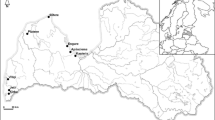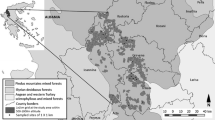Abstract
Alpine pastures are typical examples of “high nature value farmlands”, representing important habitats harbouring unique biological communities. Disturbance induced by overgrazing influences significantly ecosystem processes, in which invertebrates play a major role. To develop new models of sustainable management of pastures, more knowledge is needed of the animal communities, essential to the ecological functioning of pasture ecosystems. The apparent poor ecological state of several pastures in the Natural Regional Park of Alpi Marittime (NW-Italy) lead us to evaluate the influence of grazing history on biodiversity, using spider and harvestmen assemblages as key groups. Four different pastoral types characterized by four different grazing histories were identified using the Daget-Poissonet method. Spiders and harvestmen were collected by means of pitfall traps. Arachnid assemblages were characterized in terms of composition, abundance, species richness, richness of endemic species and taxonomic relatedness. Generalized linear mixed models (GLMM) were used to test differences among assemblages occurring in each pastoral type. Furthermore, we tested differences in terms of plant communities (species richness and percentage of zoogenic species). Specificity and fidelity of every spider and harvestmen species within pastoral types were explored by the IndVal (Indicator Value) procedure. Fifty-eight species of spiders and seven species of harvestmen were collected (2,304 individuals). Pastoral types related to intensive grazing were characterized by the dominance of diurnal wanderer spiders (namely Lycosidae) while, conversely, nocturnal wanderers (mainly Gnaphosidae) were more abundant in extensive pastoral types. Results show that both species richness and spider abundance were higher in abandoned areas of extensive grazing, while endemic assemblages were richer in extensive grazed areas, which also hosted the most diverse plant community. Furthermore, most of the indicator species of spiders of this type were endemic, characterized by more demanding ecological requirements.







Similar content being viewed by others
References
Andersen E, Baldock D, Bennet H, Beaufoy G, Bignal E, Brower F, Elbersen B, Eiden G, Godeschalk F, Jones G, McCracken DI, Nieuwenhuizen W, van Eupen M, Hennekes S, Zervas G (2003) Developing a high nature value indicator. Report for the European Environment Agency, Copenhagen
Batáry P, Báldi A, Samu F, Szűts T, Erdős S (2008) Are spiders reacting to local or landscape scale effects in Hungarian pastures? Biol Cons 141:2062–2070
Bell JR, Wheater CP, Cullen WR (2001) The implication of grassland and heathland management for the conservation of spider communities: a review. J Zool 255:377–387
Bilotta GS, Brazier RE, Haygarth PM (2007) The impacts of grazing animals on the quality of soils, vegetation, and surface waters in intensively managed grasslands. Adv Agron 94:237–280
Blasi C (2010) La vegetazione d’Italia. Palombi & Partner, Roma
Cattin MF, Blandenier G, Banašek-Richter C, Bersier LF (2003) The impact of mowing as a management strategy for wet meadows on spider (Araneae) communities. Biol Cons 113:179–188
Cavallero A, Aceto P, Gorlier A, Lonati M, Lombardi G, Martinasso B and Tagliatori C (2007) I tipi pastorali delle alpi piemontesi. Alberto Perdisa Editore
Cernusca A, Tappeiner U, Bayfield N (1999) Land-use changes in European mountain ecosystems. Blackwell, Berlin
Chapin FS III, Torn MS, Tateno M (1996) Principles of ecosystem sustainability. Am Nat 148:1016–1037
Clarke KR, Gorley RN (2006) PRIMER v6. Primer-E Ltd, Plymouth
Clarke KR, Warwick RM (1998) A taxonomic distinctness index and its statistical properties. J Appl Ecol 35:523–531
Coleman DC, Hendrix PF (2000) Invertebrates as Webmasters in ecosystems. CAB International Wallingford, UK
Cribari-Neto F, Zeileis A (2010) Beta regression in R. J Stat Softw 34(2): 1–24. http://www.jstatsoft.org/v34/i02/
Daget P, Poissonet J (1971) Une méthode d’analyse phytologique des prairies. Critère d’application. Am agron 22(1):5–41
De Keer R, Maelfait J-P (1988) Laboratory observations on the development and reproduction of Erigone atra, Blackwall, 1833 (Araneae, Linyphiidae). Bull Br Arachnol Soc 7:237–242
De Keer R, Alderweireldt M, Decleer K, Segers H, Desender K, Maelfait JP (1989) Horizontal distribution of the spider fauna of intensively grazed pastures under the influence of diurnal activity and grass height. J Appl Entomol 107:455–473
Delchev K, Kajak A (1974) Analysis of a sheep pasture ecosystem Pieniny Mountains (The Carpathians) XVI. Effect of pasture management on the number and biomass of spiders (Araneae) in two climatic regions (the Pieniny and the Sredna Gora Mountains). Ekologia Polska 22:693–710
Dennis P, Young MR, Bentley C (2001) The effects of varied grazing management on epigeal spiders, harvestmen and pseudoscorpions of Nardus stricta grassland in upland Scotland. Agr Ecosyst Environ 86:39–57
Dobson AJ (1990) An introduction to generalized linear models. Chapman and Hall, New York
Dufrêne M, Legendre P (1997) Species assemblages and indicator species: the need for a fexible asymmetrical approach. Ecol Monogr 67:345–366
Finch OD, Löffler J (2010) Indicators of species richness at the local scale in an alpine region: a comparative approach between plant and invertebrate taxa. Biodivers Conserv 19:1341–1352
Fleischner TL (1994) Ecological costs of livestock grazing in western North America. Cons Biol 8:629–644
Fournier DA, Skaug HJ, Ancheta J, Ianelli J, Magnusson A, Maunder MN, Nielsen A, Sibert J (2012) AD model builder: using automatic differentiation for statistical inference of highly parameterized complex nonlinear models. Optim Methods Softw 27:233–249
Gallardo B, Gascón S, Quintana X, Comín FA (2011) How to choose a biodiversity indicator—redundancy and complementarity of biodiversity metrics in a freshwater ecosystem. Ecol Ind 11:1177–1184
Gardner SM, Hartley SE, Davies A, Palmer SCF (1997) Carabid communities on heather moorlands in northeast Scotland: the consequences of grazing pressure for community diversity. Biol Cons 81:275–286
Gibson CWD, Hambler C, Bovn VK (1992) Changes in spider (Araneae) assemblages in relation to succession and grazing management. J Appl Ecol 29:132–142
Groombridge B (1992) Global biodiversity status of the earth’s living resources. World Conservation Monitoring Centre, Chapman and Hall, London
Hammer Ø, Harper DAT, Ryan PD (2001) PAST: paleontological statistics software package for education and data analysis. Palaeontol Electron 4:1–9
Han G, Hao X, Zhao M, Wang M, Ellert BH, Willms W, Wang M (2008) Effect of grazing intensity on carbon and nitrogen in soil and vegetation in a meadow steppe in Inner Mongolia. Agr Ecosyst Environ 125(1–4):2–32
Hawksworth DL (2011) Biodiversity and conservation of insects and other invertebrates. Biodivers Conserv 20:2863–2866
Heino J (2008) Patterns of functional biodiversity and function-environment relationships in lake littoral macroinvertebrates. Limn Ocean 53:1446–1455
Hsieh Y-L, Linsenmair KE (2011) Underestimated spider diversity in a temperate beech forest. Biodiv Conserv 20. doi:10.1007/s10531-011-0158-1
Isaia M, Pantini P, Beikes S, Badino G (2007) Catalogo ragionato dei ragni (Arachnida, Araneae) del Piemonte e della Lombardia. Memorie dell’Associazione Naturalistica Piemontese 9:1–161
Kruess A, Tscharntke T (2002) Contrasting responses of plant and insect diversity to variation in grazing intensity. Biol Cons 106:293–302
Manhart C, Marschalek H, Karg J (2004) Renaturierung feucht-nassen Grünlands im Voralpenraum. Untersuchungen zur Vegetationsentwicklung sowie zur Biomasse und Diversität bei Insekten Natur und Landschaft 79:257–263
Marc P, Canard A, Ysnel F (1999) Spiders (Araneae) useful for pest limitation and bioindication. Agr Ecosyst Environ 74:229–273
Martens J (2011) Fauna Europaea: Opiliones Fauna Europaea version 24, http://www.faunaeur.org
McCraken DI, Tallowin JR (2004) Swards and structure: the interactions between farming practices and bird food resources in lowland grasslands. Ibis 146:108–114
McCune B, Mefford MJ (1999) Multivariate analysis of ecological data, version 425. MjM Software Design, Gleneden Beach
McGeoch (1998) The selection, testing and application of terrestrial insects as bioindicators. Biol Rev 73:181–201
McIntyre S, Heard KM, Martin TG (2003) The relative importance of cattle grazing in sub-tropical grasslands—does it reduce or enhance plant biodiversity? J Appl Ecol 40:445–457
Minelli A, Ruffo S, Vigna Taglianti A (2006) The Italian faunal provinces. In: Ruffo, Sand Stoch F (Eds) Checklist and distribution of the Italian fauna. Memorie del Museo Civico di Storia Naturale di Verona 17: 37–39
Montacchini F (1976) Settori floristici e settori eco- logico-vegetazionali del Piemonte. Allionia 21:83–95
Montacchini F (1992) Aspetti fitogeografici delle Alpi Occidentali. Allionia 31:121–131
Negro M, Isaia M, Palestrini C, Rolando A (2010) The impact of forest ski-pistes on diversity of ground-dwelling arthropods and small mammals in the Alps. Biodiv Conserv 19:1853–1870
Negro M, Rolando A, Palestrini C (2011) The impact of overgrazing on dung beetle diversity in the Italian Maritime Alps. Environ Entomol 40(5):1081–1092
Noellemeyer E, Quiroga AR, Esterlich D (2006) Soil quality in three range soils of the semi-arid Pampa of Argentina. J Arid Environ 65:142–155
Ozenda P (1985) La végétation de la chaîne alpine dans l’espace montagnard européen. Masson, Paris
Paracchini ML, Petersen JE, Hoogeveen Y, Bamps C, Burfield I, van Swaay C (2008) High nature value farmland in Europe—an estimate of the distribution patterns on the basis of land cover and biodiversity data. Report EUR 23480
Platnick NI (2012) The world spider catalog, version 125 American Museum of natural history. Online at http://researchamnhorg/iz/spiders/catalog. doi: 105531/dbiz0001. Accessed 20 Dec 2011
Pozzi S, Borcard D (2001) Effects of dry grassland management on spider (Arachnida : Araneae) communities on the Swiss occidental plateau. Ecoscience 8(1):32–44
Pucheta E, Cabido M, Díaz S, Funes G (1998) Floristic composition, biomass, and aboveground net plant production in grazed and protected sites in a mountain grassland of Central Argentina. Acta Oecol 19:97–105
Sasaki T, Okubo S, Okayasu T, Jamsran U, Ohkuro T, Takeuchi T (2009) Management applicability of the intermediate disturbance hypothesis across Mongolian rangeland ecosystems. Ecol Appl 19:423–432
Scrucca L (2004) qcc: an R package for quality control charting and statistical process control. R News 4(1):11–17
Southwood TRE, Reader PM, Brown VK (1979) The relationship of plant and insect diversities in succession. Biol J Linn Soc 12:327–348
Stoch F, Vigna Taglianti A (2005) I corotipi della fauna italiana. In: Ruffo S, Stoch F (eds) Checklist e distribuzione della fauna italiana. Memorie del Museo Civico di Storia Naturale di Verona, 16: 25–28
Sunderland KD, Samu F (2000) Effects of agricultural diversification on the abundance, distribution, and pest control potential of spiders: a review. Entomol Exp Appl 95:1–13
R Development Core Team (2012) R: a language and environment for statistical computing. R Foundation for Statistical Computing, Vienna. ISBN 3-900051-07-0. http://www.R-project.org/
Warui CM, Villet MH, Young TP, Jacque R (2005) Influence of grazing by large mammals on the spider community of a Kenyan savanna biome. J Arachnol 33:269–279
Wettstein W, Schmid B (1999) Conservation of arthropod diversity in montane wetlands: effect of altitude, habitat quality and habitat fragmentation on butterflies and grasshoppers. J Appl Ecol 36:363–373
Zuur AF, Ieno EN, Walker NJ, Saveliev AA, Smith GM (2009) Mixed effect models and extensions in ecology with R. Springer, Berlin
Acknowledgments
Field work has been supported by the European Distributed Institute of Taxonomy, in the framework of the ATBI + M project (All Taxa Biodiversity Inventory + Monitoring). Thanks to the Staff of the Natural Park of Alpi Marittime for logistic support. Thanks to Axel L. Schönhofer for the identification of harvestmen and to Gabriele Chiappetta and Nicola Bodino for helping in the field work. Referee one provided very useful comments and contributed substantially to the improvement of the earlier version of the manuscript.
Author information
Authors and Affiliations
Corresponding author
Appendices
Appendix 1
See Table 3.
Appendix 2
See Table 4.
Appendix 3
See Table 5.
Rights and permissions
About this article
Cite this article
Paschetta, M., La Morgia, V., Masante, D. et al. Grazing history influences biodiversity: a case study on ground-dwelling arachnids (Arachnida: Araneae, Opiliones) in the Natural Park of Alpi Marittime (NW Italy). J Insect Conserv 17, 339–356 (2013). https://doi.org/10.1007/s10841-012-9515-y
Received:
Accepted:
Published:
Issue Date:
DOI: https://doi.org/10.1007/s10841-012-9515-y




